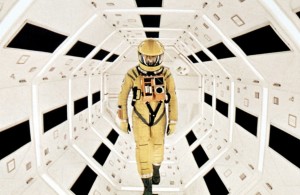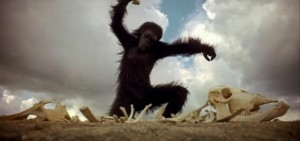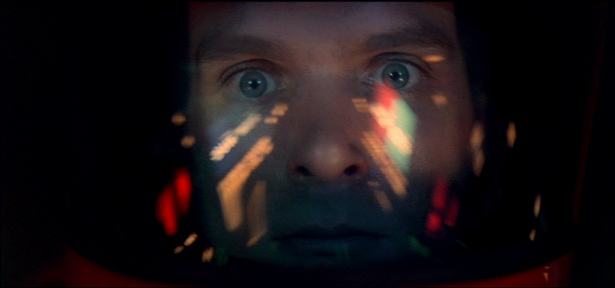As a fan and admirer of art, my apartment boasts the décor of works by Vincent van Gogh, Edward Hopper, and my favorite, Gustave Caillebotte. What I don’t care for is a white backdrop with a splash of red paint in the corner – and being told it represents some monumental struggle of mankind and that I’m some sort of miscreant for not “understanding” or looking at it with awe.
Like paintings, music, and the written word, films can also be considered a form of art, though I think it should be less about a director’s expression and more about entertainment. Written by Arthur C. Clarke and Stanley Kubrick (who also directed) no film has been made that is more synonymous with art and expression than the 1968 science fiction epic “2001: A Space Odyssey.”“2001: A Space Odyssey” is considered a cinematic masterpiece in the same way the Mona Lisa is considered to the field of art.
Kubrick made his name for his unorthodox and often controversial style films like “A Clockwork Orange,” “Full Metal Jacket,” and “Eyes Wide Shut,” and is also the master behind my all time favorite horror movie, “The Shining.”

After watching “2001: A Space Odyssey,” I’ve come to the conclusion that there is no way anyone could possibly find enjoyment in this movie and those that say they love it, say so for the sole intention of trying to be in tune with art. A review of “2001: A Space Odyssey” is tricky. It’s difficult to analyze the plot of a movie that has no plot whatsoever to analyze. Generally, I take notes for the first 30 minutes or so to document the story without divulging the plot. That was an impossibility.
The movie begins with “The dawn of man” and we are treated to nearly 30 minutes of primal ape-men grunting and galloping about. They awake one morning to the site of a mysterious black monolith before them. The ape-men are fearful at first but eventually gather the courage to touch it, after which they appear reverent to it. They then discover a way to use the thigh bone of a dead animal as a weapon; killing the leader of a rival clan and reclaiming access to a water hole.
The next segment takes place millions of years later – in 2000. We spend a good 10 minutes watching a satellite before another 30 minute scene that rivals the growth of a plant in terms of intrigue. After a spell of slow moving and unnecessary dialogue, we learn that another black monolith, identical to the one the ape-men found, has been discovered at a U.S. outpost on the moon.
 The meat of the film takes place in the third segment titled “Jupiter Mission” (over an hour in). We meet the crew of Discovery One; Dr. David Bowman (Keir Dullea) and Dr. Frank Poole (Gary Lockwood) on a mission en route to Jupiter. Also on the ship are three other scientists who have been cryogenically frozen and a computer that controls the ship called HAL (voiced by Douglas Rain). HAL is said to be a super computer that is foolproof and incapable of error. The monolith discovered on the moon was transmitting a signal to Jupiter and the mission entails finding out who or what is behind the source. The clock continues to tick as we watch the astronauts go about their day and occasionally converse with HAL. The iconic – and frankly the only scene in the entire 140 minute film worth watching – is the infamous interaction between Dave Bowman and HAL – and even that runs about 5 minutes too long.
The meat of the film takes place in the third segment titled “Jupiter Mission” (over an hour in). We meet the crew of Discovery One; Dr. David Bowman (Keir Dullea) and Dr. Frank Poole (Gary Lockwood) on a mission en route to Jupiter. Also on the ship are three other scientists who have been cryogenically frozen and a computer that controls the ship called HAL (voiced by Douglas Rain). HAL is said to be a super computer that is foolproof and incapable of error. The monolith discovered on the moon was transmitting a signal to Jupiter and the mission entails finding out who or what is behind the source. The clock continues to tick as we watch the astronauts go about their day and occasionally converse with HAL. The iconic – and frankly the only scene in the entire 140 minute film worth watching – is the infamous interaction between Dave Bowman and HAL – and even that runs about 5 minutes too long.
The movie ends with in such a head-scratching way you’ll contemplate flinging yourself off a ten-story balcony.
Every scene is “ASO” is drawn out to the point of near nausea. Each one is so drudgingly long you get the impression Kubrick did it on purpose for no other reason than to annoy people – excuse me – to connect strictly with those who can appreciate fine art, a very small segment of brilliant folk, don’t you know.

“ASO” boasts decent effects, obviously not comparing to today’s but good for the time. The score is well-known and solid, but even that gets obnoxious after a while too. The movie covers over 4 million years of time and takes almost as long to watch it.
I won’t even tell you to check it out for the sake of watching a classic. It’s simply a terrible movie that has no business having ever been made.


